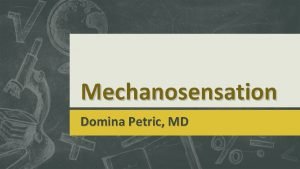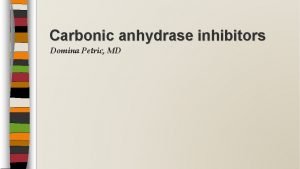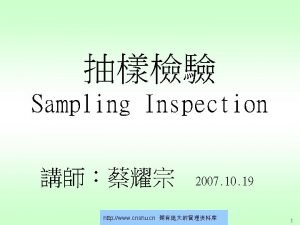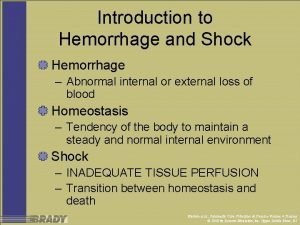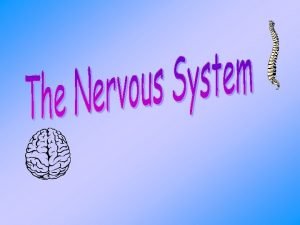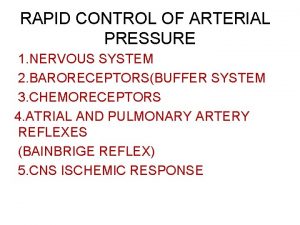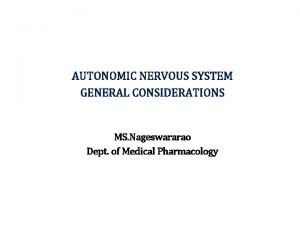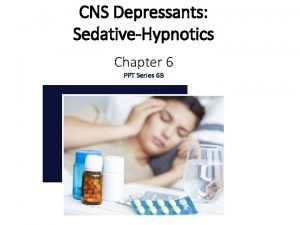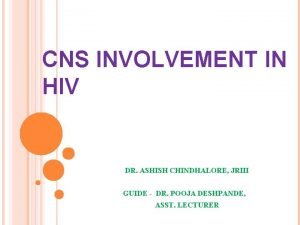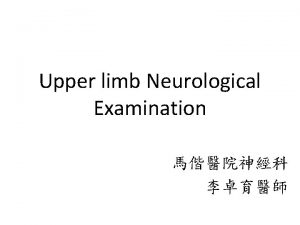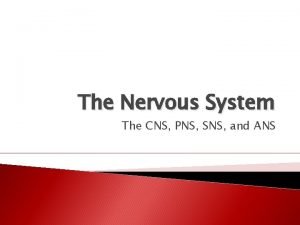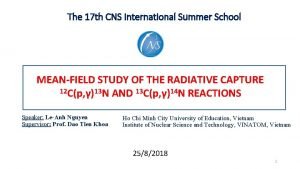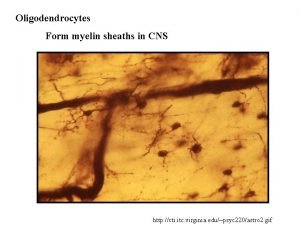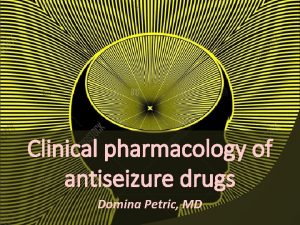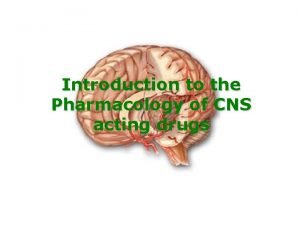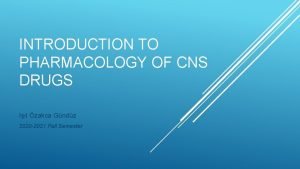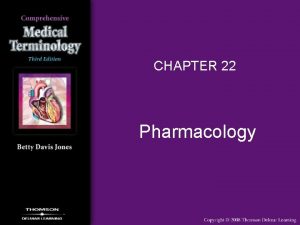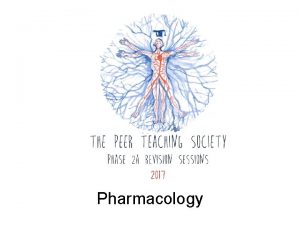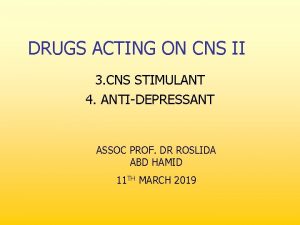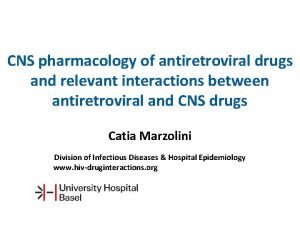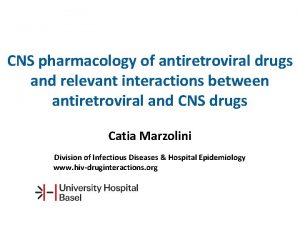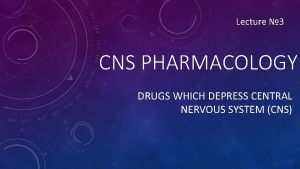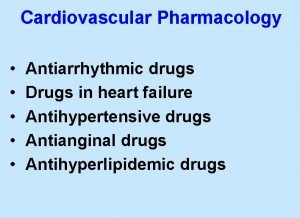Introduction to the pharmacology of CNS drugs Domina






































- Slides: 38

Introduction to the pharmacology of CNS drugs Domina Petric, MD

I. ION CHANNELS AND NEUROTRANSMITTER RECEPTORS

The membranes of nerve cells contain two types of channels: VOLTAGE GATED LIGAND GATED

Voltage-gated channels • Voltage-gated channels respond to changes in the membrane potential of the cell. • In nerve cells, voltage-gated sodium channels are concentrated on the initial segment and on the axon. • These channels are responsible for the fast action potential, which transmits the signal from cell body to nerve terminal.

Voltage-gated channels • There are many types of voltagesensitive calcium and potassium channels on the cell body, dendrites and initial segment, which act on a much slower time scale and modulate the rate at which the neuron discharges.

Voltage-gated channels • Some types of potassium channels oponed by depolarization of the cell result in slowing of further depolarization and act as a brake to limit further action potential discharge.

Neurotransmitters bind on: ionotropic receptors metabotropic receptors

Ionotropic receptors • The receptor consists of subunits. • Binding of ligand directly opens the channel. • Channel is an integral part of the receptor complex. • These channels are insensitive or only weakly sensitive to membrane potential.

Ionotropic receptors • Activation of ionotropic receptors results in a brief (a few milliseconds to tens of milliseconds) opening of the channel. • Ligand-gated ionotropic channels are responsible for fast synaptic transmission typical of hierarchical pathways in the CNS.

Metabotropic receptors • These are seven-transmembrane G protein-coupled receptors. • Binding to the receptor engages a G protein, which results in the production of second messengers that modulate voltage-gated channels.

Membrane-delimited pathways When G proteins interact with calcium channels, they inhibit channel function: presynaptic inhibition. When these receptors are postsynaptic, they activate potassium channels: slow postsynaptic inhibition.

Diffusible second messengers Example: β adrenoreceptor generates c. AMP via the activation of adenylyl cyclase.

Metabotropic receptors • Membrane-delimited actions occur within microdomains in the membrane. • Second messenger-mediated effects can occur over considerable distances. • The effects of metabotropic receptor activation can last tens of seconds to minutes.

Metabotropic receptors predominate in the diffuse neuronal systems in the CNS.

II. THE SYNAPSE AND SYNAPTIC POTENTIALS

Synapses • The communication between neurons in the CNS occurs through chemical synapses in the majority of cases. • Electrical coupling between neurons may play a role in synchronizing neuronal discharge.

Propagation of action potential • An action potential in the presynaptic fiber propagates into the synaptic terminal and activates voltage-sensitive calcium channels in the membrane of the terminal. • Calcium flows into the terminal. • The increase in intraterminal calcium concentration promotes the fusion of synaptic vesicles with the presynaptic membrane.

Propagation of action potential • The transmitter contained in the vesicles is released into the synaptic cleft and diffuses to the receptors on the postsynaptic membrane. • Binding of the transmitter to its receptor causes a brief change in membrane conductance (permeability to ions) of the postsynaptic cell.

Propagation of action potential The time delay from the arrival of the presynaptic action potential to the onset of the postsynaptic response is 0, 5 ms.

EPSP When an excitatory pathway is stimulated, a small depolarization or excitatory postsynaptic potential (EPSP) is recorded. Excitatory transmitter is acting on an ionotropic receptor causing an increase in cation permeability. When sufficient number of excitatory fibers are activated, the EPSP depolarizes the postsynaptic cell to threshold: all-or-none action potential is generated.

IPSP When an inhibitory pathway is stimulated, the postsynaptic membrane is hyperpolarized owing to the selective opening of chloride channels: inhibitory postsynaptic potential (IPSP). Equilibrium potential for chloride is only slightly more negative than the resting potential (-65 m. V): the hyperpolarization is small and contributes only modestly to the inhibitory action.

IPSP • The opening of the chloride channel during the inhibitory postsynaptic potential makes the neuron leaky. • Changes in membrane potential are more difficult to achieve. • This shunting effect decreases the change in membrane potential during the excitatory postsynaptic potential.

Presynaptic inhibition • Axoaxonic synapses reduce the amount of transmitter released from the terminals of sensory fibers. • Presynaptic inhibitory receptors are present on almost all presynaptic terminals in the brain. • Axoaxonic synapses are restricted to the spinal cord.

III. CELLULAR ORGANIZATION OF THE BRAIN

Cellular organization of the brain HIERARCHICAL SYSTEMS NONSPECIFIC OR DIFFUSE NEURONAL SYSTEMS

Hierarchical systems include all the pathways directly involved in sensory perception and motor control. The pathways are generally clearly delineated, being composed of large myelinated fibers that can often conduct action potentials at a rate of more than 50 m/s.

Hierarchical systems • Information in hierarchical systems is typically phasic and occurs in bursts of action potential. • In sensory systems, the information is processed sequentially by successive integrations at each relay nucleus on its way to the cortex: a lesion at any link incapacitates the system.

Two types of cells are: RELAY OR PROJECTION NEURONS LOCAL CIRCUIT NEURONS

Projection neurons • The projection neurons form the interconnecting pathways and transmit signals over long distances. • The cell bodies are relatively large. • Their axons emit collaterals that arborize extensively in the vicinity of the neuron. • These neurons are excitatory.

Projection neurons Synaptic influence of projection neurons involves ionotropic receptors. Their influence is very short-lived. The excitatory transmitter is GLUTAMATE.

Local circuit neurons • Local circuit neurons are smaller than projection neurons. • Their axons arborize in the immediate vicinity of the cell body. • Most of these neurons are inhibitory: they release GABA or glycine.

Local circuit neurons • They synapse primarily on the cell body of the projection neurons. • They can also synapse on the dendrites of projection neurons as well as with each other. • Two common types of pathways are recurrent feedback pathways and feedforward pathways.

Local circuit neurons • A special class of local circuit neurons are axoaxonic synapses on the terminals of sensory axons in the spinal cord. • In the retina and olfactory bulb, local circuit neurons may lack an axon and release neurotransmitter from dendritic synapses in a graded fashion, in the absence of action potential.

Nonspecific (diffuse) systems Neuronal systems that contain one of the monoamines: • norepinephrine • dopamine • 5 -hydroxytryptamine (serotonin)

Example: noradrenergic neurons Noradrenergic cell bodies are found primarily in a compact cell group locus caeruleus.

Noradrenergic neurons • These axons are fine and unmyelinated. • They conduct very slowly at about 0, 5 m/s. • The axons branch repeatedly and are extraordinarily divergent. • Branches from the same neuron can innervate several functionally different parts of the CNS.

Noradrenergic neurons • In the neocortex, these fibers have a tangential organization and can monosynaptically influence large areas of cortex. • The pattern of innervation by noradrenergic fibers in the cortex and nuclei of the hierarchical system is diffuse.

Literature • Katzung, Masters, Trevor. Basic and clinical pharmacology.
 Pharmacology of drugs acting on respiratory system
Pharmacology of drugs acting on respiratory system Adrenal drugs pharmacology
Adrenal drugs pharmacology Slidetodoc
Slidetodoc Competitive antagonist
Competitive antagonist Quasi vitamin b
Quasi vitamin b Domina petric
Domina petric Rexocef 100
Rexocef 100 Domina petric
Domina petric 8 atitudes vencedoras
8 atitudes vencedoras Domina los aprendizajes requeridos
Domina los aprendizajes requeridos Domina petric
Domina petric Domina petric
Domina petric Cada miembro domina una parcela determinada del proyecto.
Cada miembro domina una parcela determinada del proyecto. Domina severe
Domina severe Kitzler witze
Kitzler witze Domina epistulam
Domina epistulam Domina tasks
Domina tasks Cns2779-1
Cns2779-1 Naas cns
Naas cns Cns ischemic response
Cns ischemic response Histology of nervous tissue ppt
Histology of nervous tissue ppt Composition of cns
Composition of cns Cns ischemic response
Cns ischemic response Mean arterial pressure
Mean arterial pressure Cns ischemic response
Cns ischemic response Www.lispa.it cns
Www.lispa.it cns Ans and cns difference
Ans and cns difference Cns depressants ppt
Cns depressants ppt Tuberculomas
Tuberculomas Depresori cns
Depresori cns Cns international school
Cns international school Cns poruchy
Cns poruchy Muscle power grading scale
Muscle power grading scale Dermatomes
Dermatomes Neutron capture
Neutron capture Areas of forebrain
Areas of forebrain Cns ward
Cns ward Cns
Cns Diagram of central nervous system
Diagram of central nervous system











